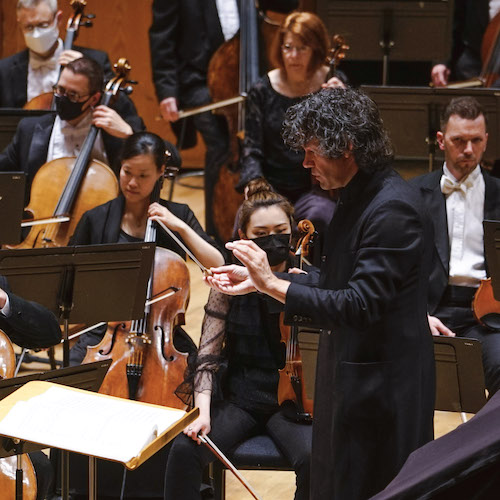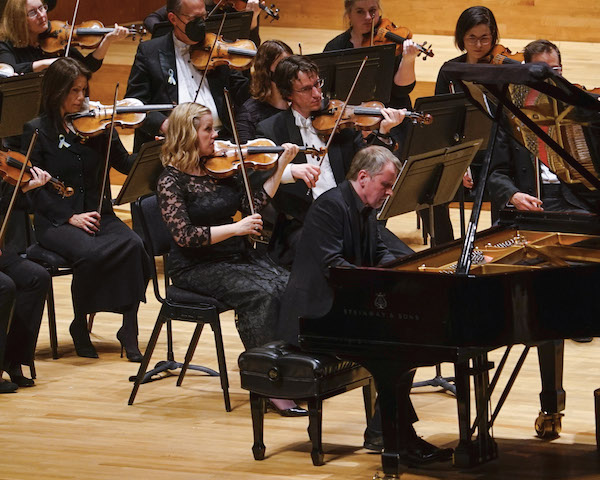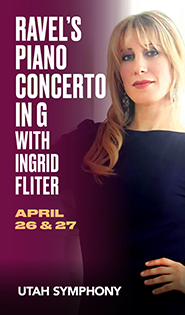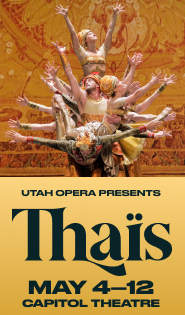Jensen tamps down Utah Symphony sound in rich Russian program

In a season filled with new works that challenged the audience—including three pieces from composer- in-association Arlene Sierra —Friday’s Utah Symphony program consisting solely of music by Rachmaninoff and Tchaikovsky seemed bracingly retro.
While the orchestra does “play the hits”, most concerts this season have included a 20th or 21st century piece—like Ginastera’s serialist Violin Concerto, which Hilary Hahn performed earlier this month.
In addition to the less-than-adventurous repertoire, what set this concert apart was the sound of the orchestra. Eivind Gullberg Jensen, who holds posts in Norway and the Netherlands, appeared to tamp down the rich, full orchestral sound cultivated by music director Thierry Fischer. This slenderizing was most noticeable in the strings, which had a less shimmery tone. Jensen’s conducting style is also very different from Fischer’s, including grandiose gestures that did not always manifest itself in the orchestra
Still, Jensen’s innate musicality was infectious in his Salt Lake City debut, and his tidy, fastidious interpretations included some exquisite moments. The appreciative, near-capacity audience skewed younger than normal, perhaps including current and former piano students there to hear Rachmaninoff’s Second Piano Concerto played by British pianist Steven Osborne. The concerto was sandwiched between Rachmaninoff’s Vocalise and Tchaikovsky’s Symphony No. 6, the “Pathetique.”
Despite the lack of shimmer in the strings, the orchestra’s rendition of the Vocalise was engaging. Jensen focused on the phrasing, which was exact and focused on the piece’s two-beat motives and 1-2 bar swells. As a whole, the piece provided the perfect lead-in to the concerto.
Osborne had surgical tape on at least one finger of his right hand, and the way they landed on a few notes suggested he may have been playing with a minor injury that rendered him less than 100 per cent.

Even with that, his performance was powerful and engaging. The most salient quality was the way the melody of each phrase rose clearly and emphatically above the orchestra and the intricate piano accompaniment. However, he sometimes sacrificed musicality for clarity, and his touch, which tended toward marcato throughout, turned harsh.
This was true in the first movement, where his introduction of the rapturous E-flat major theme lacked phrasing and shape. However, he found his voice in the movement’s moody development section, to which he gave an authoritative passion.
Osborne’s tone served him well in the slow movement, making the melody more forceful and emphatic, and his judicious use of rubato in the solo passages accentuated piece’s sense of drama. Osborne and the orchestra listened well to one another, especially in a lovely lyrical section where he traded phrases with associate principal clarinet Erin Svoboda. Osborne and the orchestra captured the movement’s wistfulness, and the emotion built to a climax in the cadenza, which Osborne delivered with panache.
In the virtuosic third movement, Osborne’s bandaged fingers only slightly hampered his technique, and his interpretation came through clearly. While the tone in the strings remained thin and dry, Jensen’s phrasing captured the piece’s overt sentimentality, which Osborne carried through the piece’s thunderous climax, garnering an enthusiastic ovation from the audience.
As an encore, Osborne played an improvisation on the opening theme from jazz pianist Keith Jarrett’s live album “The Vienna Concert.” Slow and contemplative, with thick, colorful chords, the piece showcased Osborne’s musicality and soulfulness better than the Rachmaninoff and his performance was spellbinding.
Unfortunately, the spell was broken by a phone going off in the hall just as he was landing on the final cadence. It’s not clear whether he would have continued improvising had he not been so rudely interrupted, but either way, it was an unwelcome intrusion.
The strings’ usual shimmer was most missed in the first movement of the Tchaikovsky’s Sixth, rendering the funeral opening in the bassoon and low strings somewhat anemic. However, the sunny second theme that quickly overtakes it was nimbly phrased and full of life, with Jensen paying close attention to the articulation and melodic line. While the mood was intense, the climactic moments were held back by the lack of fullness in the orchestra, and the movement seemed to lack direction.
The second movement—an “almost waltz” in 5/4 time—was charming, with an engaging lilt aided by Jensen’s careful phrasing of the scalar patterns in the counterpoint. The third movementwas infectious, an exultant march to which he gave a spritely energy.
The orchestra sounded most like its regular self in the final movement, a tragic tour de force that also showcased Jensen’s soulfulness. Although Jensen continued to tamp down the vibrato, the phrasing in the strings was exquisite, and Jensen gave weight to each phrase by accentuating the pauses between them. After the final cadence, he hoped to have a few moments of silence, but the audience broke in with a standing ovation before he signaled that the piece was done.
This program will be repeated 5:30 p.m. Saturday. usuo.org

